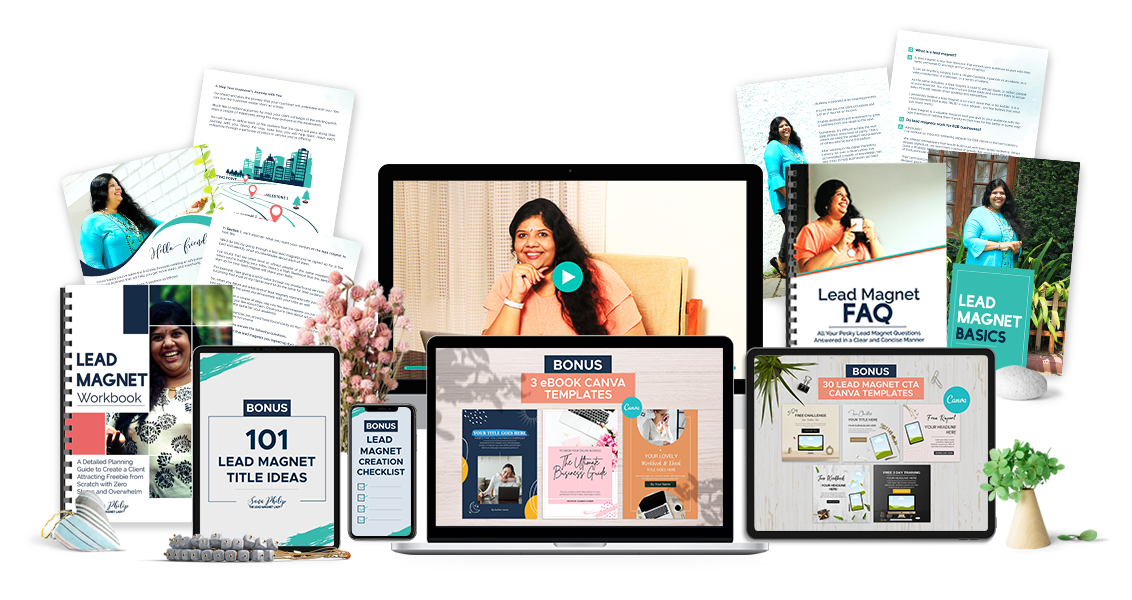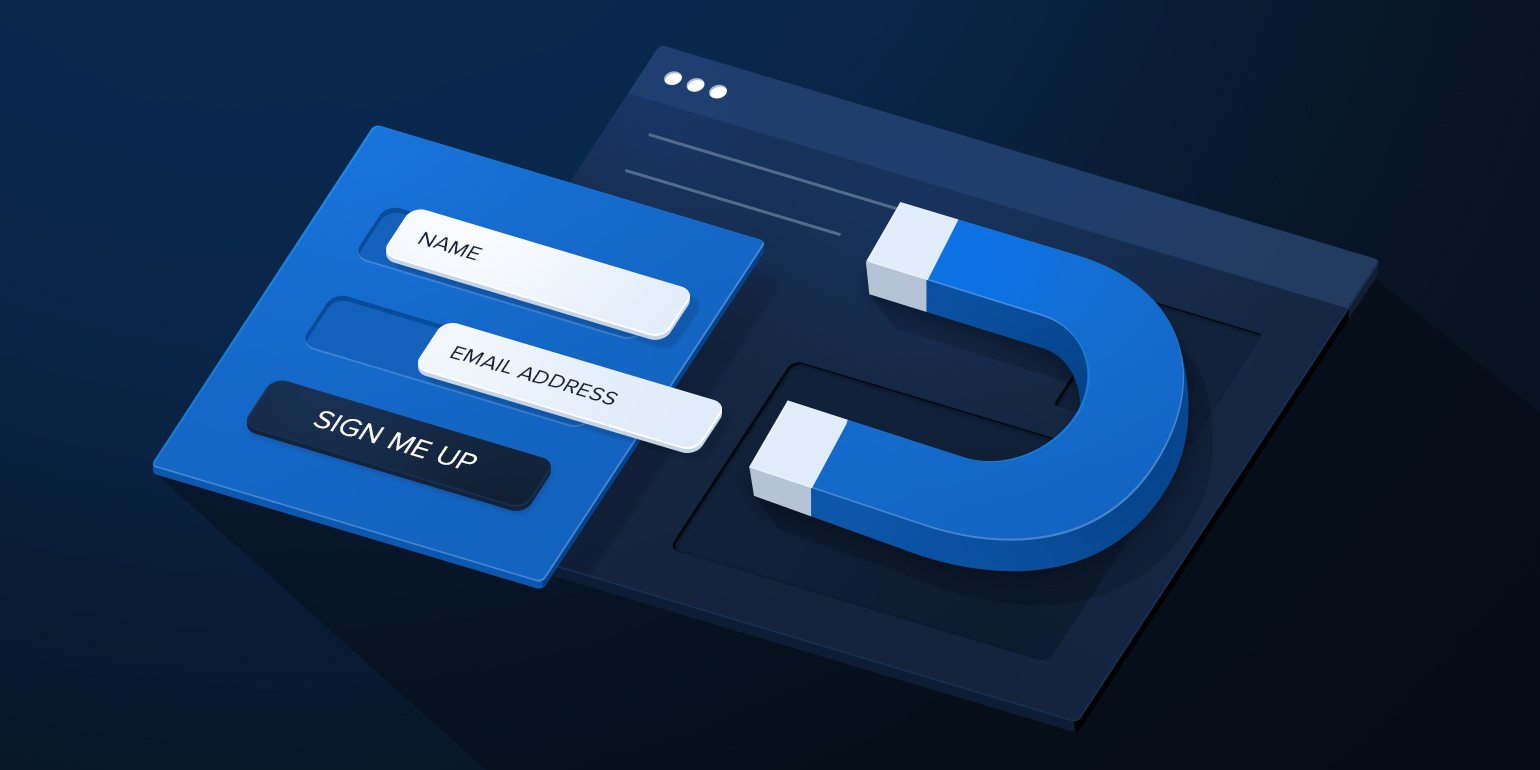
The Loyalty Advantage: How AI Marketing Recommendations Keep Customers Coming Back
September 19, 2025
AI Marketing in Action: Predicting and Preventing Customer Churn
September 19, 2025What Is a Lead Magnet?
In the vast digital landscape, a lead magnet serves as your beacon, a magnetic force that pulls potential customers closer to your brand. Imagine it as the enticing aroma of freshly baked cookies wafting from a bakery, drawing people in. A lead magnet, in its essence, is a valuable piece of content, an offer, or an incentive that you present to your target audience in exchange for their contact information, typically their email addresses. This information is gold in the world of B2B marketing.
Why are lead magnets vital in B2B marketing, you may wonder? Well, in the realm of business-to-business interactions, decision-makers often guard their email addresses with a fervour akin to a dragon guarding its treasure. Gaining access to this treasure trove of contact information is akin to unlocking the gateway to building a more meaningful and personalized relationship with potential clients.
Types of Lead Magnets
Lead magnets come in various forms, each tailored to meet specific objectives and resonate with different segments of your audience. Let’s explore some common types:
- eBooks: Information is power, and eBooks are an excellent medium for sharing in-depth knowledge. They allow you to delve into complex topics, showcase your expertise, and provide comprehensive solutions to your audience’s pain points.
- Webinars: Hosting webinars positions you as an industry authority and allows for direct engagement with your audience. It’s an ideal platform to discuss trends, share insights, and address questions.
- Templates and Toolkits: Offering practical templates, checklists, or toolkits can simplify tasks for your audience. These resources not only save them time but also highlight the value you bring to their workflow.
- Quizzes and Assessments: Interactive quizzes are engaging and provide a personalized experience. They can help prospects identify their pain points and receive tailored recommendations.
- Case Studies: Real-world success stories resonate with businesses. Sharing case studies showcasing how your product or service solved specific problems for clients can be highly persuasive.
Crafting an Irresistible Offer
Creating a lead magnet that your audience can’t resist is both an art and a science. It requires a deep understanding of your audience’s needs, pain points, and aspirations. Here’s how you can craft an irresistible offer:
- Research Thoroughly: Before even thinking about your lead magnet, conduct extensive research into your target audience. Understand their challenges, goals, and pain points. This insight will guide your content creation.
- Focus on Value: Your lead magnet should provide immediate and tangible value to your audience. It should address a specific problem or question they have and offer a solution or valuable information.
- Solve a Pain Point: Identify a pressing pain point within your industry and craft your lead magnet to directly address it. When you alleviate a pain point, you become a trusted resource.
- Clear and Compelling Title: The title of your lead magnet should be clear and convey the benefit it offers. Avoid jargon or vague language.
- High-Quality Content: Whether it’s an eBook, a webinar, or a toolkit, ensure that the content is well-researched, well-written, and professionally designed. High-quality content builds trust.
- Leverage Storytelling: If applicable, use storytelling to engage your audience emotionally. Stories resonate and can make your lead magnet more memorable.
- Promote Creatively: Once your lead magnet is ready, don’t just slap it on your website and hope for the best. Promote it creatively through various channels, as we’ll explore in the later sections.
By investing time and effort into crafting an irresistible offer, you lay the foundation for a successful lead magnet campaign that will turbocharge your B2B lead generation strategy.

Understanding Your Target Audience
Building Detailed Buyer Personas
In the world of marketing, one size rarely fits all. That’s where buyer personas come into play. Buyer personas are detailed, semi-fictional representations of your ideal customers. They help you understand your audience’s needs, preferences, and pain points on a deeper level.
Creating buyer personas involves a combination of research and imagination. You gather data from various sources, including customer surveys, social media insights, and website analytics. You interview existing customers and delve into their motivations and challenges. Then, you use this data to construct personas that represent different segments of your target audience.
Why is this important? Well, think of it this way: if you were planning a party, you wouldn’t invite just anyone. You’d consider the tastes and preferences of your guests, ensuring that you provide an enjoyable experience. Similarly, in marketing, you want to tailor your efforts to resonate with specific groups of people. Buyer personas help you do just that.
Identifying Pain Points and Needs
Once you’ve created detailed buyer personas, the next step is to identify the pain points and needs of each persona. This involves getting into the mindset of your ideal customers and understanding what keeps them up at night and what solutions they’re seeking.
For example, let’s say you’re a software company targeting small businesses. One of your buyer personas might be Sarah, a small business owner. Through research, you’ve discovered that Sarah’s pain points include managing her finances efficiently and automating repetitive tasks. She needs software that can simplify these aspects of her business.
Understanding Sarah’s pain points and needs allows you to tailor your lead magnets to address them directly. In this case, you might create an eBook titled “The Ultimate Guide to Streamlining Small Business Finances” as a lead magnet.
Segmenting Your Audience
Not all of your customers are the same. They have different needs, preferences, and pain points. That’s where audience segmentation comes into play. Segmentation involves dividing your audience into distinct groups based on common characteristics or behaviours. This allows you to create targeted marketing campaigns and lead magnets that resonate with each segment.
Let’s continue with the example of the software company. In addition to Sarah, your research reveals another persona, Michael, who is a small business IT manager. Michael’s pain points include network security and data backup solutions. These are entirely different from Sarah’s concerns.
By segmenting your audience into groups like Sarah and Michael, you can create lead magnets that are highly relevant to each segment. This increases the chances of capturing their contact information and nurturing them towards a sale.
Tailoring Lead Magnets to Different Segments
Once you’ve identified and segmented your audience, it’s time to tailor your lead magnets to each group. Remember, the goal is to provide value and solutions that specifically address their pain points and needs.
For Sarah, the small business owner, you might offer an eBook that outlines the benefits of your software in simplifying financial management and automating tasks. You could also provide templates or checklists to help her get started.
On the other hand, for Michael, the IT manager, you might create a webinar on network security best practices or a toolkit that includes data backup guides and resources.
The key here is customization. Your lead magnets should feel like they were created with each segment in mind. This level of personalization increases the chances of engagement and conversion.
By understanding your target audience, creating detailed buyer personas, identifying pain points, segmenting your audience, and tailoring your lead magnets accordingly, you set the stage for highly effective B2B lead generation that speaks directly to the hearts and minds of your prospects.

Designing High-Converting Lead Magnets
The Anatomy of an Effective Lead Magnet
Now that we’ve explored the importance of understanding your audience and tailoring your lead magnets to their needs, let’s delve into the essential components that make a lead magnet highly effective.
An effective lead magnet is like a well-crafted dish—it has the right ingredients, the perfect presentation, and a taste that leaves your audience craving for more. Here’s what goes into the recipe:
- Clear Value Proposition: Your lead magnet should communicate the value it offers to the audience. What problem does it solve? What benefit does it provide? A compelling value proposition sets the stage for conversion.
- Relevance: The content of your lead magnet should align with the interests and pain points of your target audience. It should speak directly to their needs, making them feel that it was created specifically for them.
- Professional Design: Visual appeal matters. Whether it’s an eBook, a webinar, or a checklist, your lead magnet should be well-designed. Invest in professional graphics and layouts to make it visually appealing and easy to consume.
- Actionable Content: Your lead magnet should provide actionable information or resources. It’s not just about theory; it should empower your audience to take concrete steps or make informed decisions.
- Minimal Friction: Make it easy for your audience to access the lead magnet. If you’re collecting email addresses, keep the form simple and ask for only essential information. Minimize barriers to entry.
- High-Quality Content: This cannot be emphasized enough. Your lead magnet content should be well-researched, accurate, and well-written. Quality builds trust.
- Branding: Ensure that your lead magnet reflects your brand. Use consistent branding elements, such as logos and colors, to create a cohesive experience.
- Mobile-Friendly: In an increasingly mobile world, your lead magnet should be accessible and easy to view on various devices, including smartphones and tablets.
Understanding these elements is crucial because they form the foundation of an effective lead magnet. Whether you’re creating an eBook, a webinar, or any other type of lead magnet, these principles apply.
Visual Appeal and User-Friendly Formats
The visual presentation of your lead magnet plays a significant role in capturing and retaining your audience’s attention. Visual appeal goes beyond just aesthetics; it’s about making the content easily digestible and engaging.
Consider the following tips to enhance the visual appeal and user-friendliness of your lead magnets:
- Use Engaging Images: Incorporate relevant and high-quality images that complement your content. Visuals can help break up text and make the content more engaging.
- Readable Typography: Choose readable fonts and font sizes. Ensure that text is legible on all devices, including mobile.
- Whitespace: Don’t overcrowd your design with text and images. Use whitespace strategically to create a clean and organized layout.
- Consistent Branding: Maintain consistent branding throughout your lead magnet. Use your brand colors, fonts, and logos to reinforce your identity.
- Bullet Points and Lists: Use bullet points and numbered lists to make information scannable. This is especially effective for checklists and resource guides.
- Visual Hierarchy: Highlight key points, headings, and calls to action using visual hierarchy. Use different font sizes, colors, or styles to guide the reader’s eye.
- Mobile Optimization: Test your lead magnet on various devices to ensure it looks and functions well on smartphones and tablets. Responsive design is essential.
- Interactive Elements: If applicable, consider adding interactive elements like clickable buttons or links. Interactive content can boost engagement.
Remember that user-friendly formats can vary depending on the type of lead magnet. An eBook may have a different design approach than a webinar presentation. Tailor your design to suit the medium and the preferences of your target audience.
Content Creation Tips
Creating compelling content is at the heart of any successful lead magnet. Here are some content creation tips to make your lead magnets shine:
- In-Depth Research: Invest time in research to ensure your content is accurate, up-to-date, and valuable. Cite credible sources and provide references when necessary.
- Solve a Problem: Focus on addressing a specific problem or challenge your audience faces. Provide practical solutions and actionable steps.
- Engaging Headlines: Craft attention-grabbing headlines and subheadings. Use clear and benefit-driven language to entice readers to continue.
- Visual Elements: Incorporate visuals like images, charts, and graphs to illustrate key points. Visuals can make complex information easier to understand.
- Storytelling: If relevant, use storytelling to connect with your audience emotionally. Share real-life examples or case studies that resonate with their experiences.
- Clear Structure: Organize your content logically with a clear beginning, middle, and end. Use headings and subheadings to break up sections.
- Concise Language: Be concise in your writing. Avoid unnecessary jargon or verbosity. Get to the point and keep your audience’s time in mind.
- Actionable Takeaways: Every section of your lead magnet should provide actionable takeaways. Encourage your audience to apply what they’ve learned.
Incorporating Call-to-Actions
A lead magnet without a clear call-to-action (CTA) is like a ship without a rudder—it may float, but it won’t reach its destination. Your CTA is the bridge that guides your leads from the lead magnet to the next step in your sales funnel.
Here are tips for incorporating effective CTAs in your lead magnets:
- Clarity: Your CTA should be crystal clear. Use straightforward language that tells your audience exactly what action you want them to take. For example, “Download Now” or “Sign Up Today.”
- Visibility: Place your CTA where it’s highly visible. It should be easily accessible without requiring the reader to scroll excessively.
- Benefit-Oriented: Emphasize the benefit of taking the action. Instead of just saying “Click Here,” say something like “Click Here to Get Instant Access to Exclusive Tips.”
- Design: Make your CTA visually stand out. Use contrasting colors and consider using buttons or banners to draw attention.
- Relevance: Ensure that your CTA aligns with the content of the lead magnet. If your lead magnet is about email marketing, the CTA should be related to email marketing.
- Testing: Don’t settle for one CTA. A/B test different versions to see which one performs better. You might be surprised by the results.
Incorporating these elements into your lead magnets, whether they are eBooks, webinars, templates, or any other format, can significantly increase their effectiveness in capturing leads and moving them along the sales funnel.

Promoting Your Lead Magnets
Leveraging Multiple Channels
Creating a fantastic lead magnet is just the first step. To maximize its impact, you need to ensure it reaches a broad audience. This involves leveraging multiple channels to promote your lead magnets effectively.
Here are some channels you can use to get the word out:
Your Website: Your website is your digital hub. Make sure your lead magnet is prominently featured on your homepage and relevant landing pages. Use eye-catching banners or pop-ups (with care) to capture visitor attention.
- Blog Posts: If you regularly publish blog content, integrate your lead magnet into relevant articles. For example, if you have a lead magnet about social media strategy, promote it within blog posts related to social media marketing.
- Social Media: Share your lead magnet on your social media profiles. Craft engaging posts that highlight the value of your offer. You can also use paid advertising on platforms like Facebook and LinkedIn to reach a larger audience.
- Email Marketing: Your existing email list is a valuable asset. Send out dedicated email campaigns to your subscribers, showcasing the lead magnet and explaining how it can benefit them.
- Guest Blogging: Write guest posts for industry-relevant websites and include a call-to-action that directs readers to your lead magnet. This not only promotes your offer but also establishes your authority in your niche.
- Collaborations and Partnerships: Partner with influencers or complementary businesses to cross-promote your lead magnet. Joint webinars, co-hosted events, or co-authored content can be powerful.
- Content Syndication: Share your lead magnet on content syndication platforms where your target audience frequents. These platforms can extend your reach beyond your website.
- Webinars and Podcasts: If you have the opportunity to host webinars or be a guest on podcasts, promote your lead magnet during these sessions. Audiences are often more engaged and receptive during live events.
The key to effective promotion is to be strategic. Tailor your approach to each channel and audience segment. Consider creating different messaging and visuals for each platform to maximize engagement.
Email Marketing Strategies
Email marketing is a powerful tool for promoting your lead magnets and nurturing leads. Here are some email marketing strategies to consider:
- Dedicated Emails: Send dedicated emails that introduce your lead magnet and explain its benefits. Include a clear CTA that directs recipients to download or access the offer.
- Segmentation: Segment your email list based on user behavior and interests. Send personalized email campaigns that target specific segments with lead magnets relevant to their needs.
- Autoresponders: Set up autoresponder sequences that deliver your lead magnet immediately after someone subscribes to your list. This provides instant value and engagement.
- Follow-Up Sequences: After someone downloads your lead magnet, don’t stop there. Create follow-up email sequences that provide additional value, nurture the relationship, and guide leads toward a conversion.
- A/B Testing: Test different subject lines, email copy, and visuals to optimize open rates and click-through rates. A/B testing can help you refine your email marketing strategy over time.
- Social Proof: Incorporate social proof in your emails. Share testimonials, case studies, or success stories related to your lead magnet to build trust and credibility.
- Scarcity and Urgency: Create a sense of urgency by mentioning limited availability or time-bound offers in your emails. This can prompt action.
Remember that email marketing is not just about sending promotional emails. It’s about building relationships and providing value to your subscribers. Your lead magnets are a key part of this value proposition.
Social Media Promotion
Social media platforms offer a vast audience that can be tapped into to promote your lead magnets. Here’s how to effectively promote your lead magnets on social media:
- Visual Posts: Use eye-catching visuals, such as images or graphics, in your social media posts. Visual content tends to perform better on social platforms.
- Teasers: Create teaser posts that generate curiosity about your lead magnet. Pose questions or share intriguing snippets of the content to pique interest.
- Video Content: Videos are highly engaging on social media. Create short videos or animations that highlight the benefits of your lead magnet.
- Stories: Utilize story features on platforms like Instagram and Facebook to promote your lead magnets. Stories have a sense of immediacy that can encourage quick action.
- Hashtags: Use relevant hashtags in your posts to increase discoverability. Research popular industry-related hashtags and include them in your social media strategy.
- LinkedIn: If your target audience is primarily in the B2B space, don’t forget about LinkedIn. Share your lead magnet in LinkedIn posts, articles, and through direct messaging.
- Engage with Comments: Respond to comments and engage with your audience on social media. Encourage discussions related to your lead magnet topic.
- Ad Campaigns: Consider running paid advertising campaigns on social media platforms to reach a larger and more targeted audience.
Remember that consistency is key in social media promotion. Create a content calendar to plan and schedule your posts strategically. Engage with your audience genuinely and respond to inquiries promptly.
Collaborations and Partnerships
Collaborations and partnerships can amplify the reach of your lead magnets by tapping into the existing audience of your partners. Here’s how to make the most of collaborations:
- Identify Complementary Businesses: Look for businesses or influencers in your niche that complement your offerings. For example, if you offer social media marketing services, partnering with a content creation agency could be valuable.
- Joint Content Creation: Collaborate on content creation. This could involve co-authoring blog posts, co-hosting webinars, or creating joint resources. Each partner promotes the content to their respective audience.
- Cross-Promotion: Promote each other’s lead magnets or offerings to your respective email lists and social media followers. Ensure that the promotion aligns with the interests of your audiences.
- Affiliate Partnerships: Consider affiliate partnerships where your partners promote your lead magnet in exchange for a commission on resulting sales or conversions.
- Exclusive Offers: Create exclusive offers for the audiences of your partners. This can incentivize their audience to engage with your lead magnet.
Collaborations and partnerships can be mutually beneficial. They allow you to tap into new audiences while providing value to your partners’ followers. When choosing partners, prioritize those whose audience aligns closely with your target demographic.

Measuring and Analyzing Lead Magnet Performance
Key Metrics to Track
As the saying goes, “What gets measured gets managed.” Tracking key metrics is essential for assessing the performance of your lead magnets and making data-driven improvements. Here are some key metrics to monitor:
- Conversion Rate: This is the percentage of people who download or access your lead magnet after seeing the offer. A higher conversion rate indicates an effective lead magnet.
- Click-Through Rate (CTR): In email marketing or paid advertising, CTR measures the percentage of recipients who clicked on the CTA or link to your lead magnet.
- Bounce Rate: For landing pages or websites promoting your lead magnet, the bounce rate indicates the percentage of visitors who leave the page without taking any action.
- Lead Quality: Assess the quality of leads generated through your lead magnet. Are they the right fit for your business? Are they likely to convert into customers?
- Engagement Metrics: For content-based lead magnets like webinars or videos, track engagement metrics such as the average watch time, interactions, and comments.
- Conversion Funnel: Analyze the entire conversion funnel, from initial interaction with the lead magnet to the ultimate conversion (e.g., purchase or sign-up).
- Cost per Conversion: Calculate how much it costs to acquire a lead or customer through your lead magnet. This is particularly important for paid advertising campaigns.
- Subscriber Growth: If your lead magnet involves email sign-ups, monitor the growth of your email subscriber list.
- Retention Rate: For lead magnets that involve ongoing engagement, such as email sequences, monitor the retention rate to ensure subscribers stay engaged over time.
These metrics provide insights into the effectiveness of your lead magnet strategy. They help you identify areas that need improvement and allow you to make data-driven decisions to optimize your campaigns.
A/B Testing for Optimization
A/B testing, also known as split testing, is a method for optimizing your lead magnets by comparing two versions of a variable to see which performs better. Here’s how you can use A/B testing effectively:
- Identify Variables: Start by identifying the variables you want to test. These could include headlines, CTA buttons, images, email subject lines, or landing page layouts.
- Create Variations: For each variable, create two different versions—a control version (A) and a variation (B). These versions should differ only in the variable you’re testing.
- Randomized Testing: Ensure that the versions are randomly shown to your audience. For example, half of your website visitors might see version A, while the other half sees version B.
- Measure Results: Track the performance of each version using relevant metrics. For example, if you’re testing email subject lines, compare open rates and click-through rates.
- Statistical Significance: Ensure that your sample size is large enough to draw statistically significant conclusions. There are online calculators available for this purpose.
- Iterate and Implement: Based on the results, choose the version that performs better and implement it. Then, continue testing other variables to refine your strategy.
A/B testing allows you to make incremental improvements to your lead magnets and marketing campaigns over time. It’s an ongoing process of optimization that can lead to significant increases in conversion rates and overall effectiveness.
Making Data-Driven Improvements
Data-driven decision-making is at the heart of successful marketing. Once you’ve gathered data from your lead magnet campaigns and A/B tests, it’s time to make informed improvements. Here’s how to do it:
- Identify Weak Points: Analyze your data to identify weak points in your lead magnet strategy. Are there specific stages of the funnel where leads drop off? Are certain lead magnets underperforming?
- Iterate on Content: If your content-based lead magnets (e.g., webinars, eBooks) aren’t performing well, consider iterating on the content itself. Did it fully address your audience’s pain points? Can it be made more engaging or informative?
- Optimize Design: For lead magnets that involve landing pages or visuals, consider design improvements based on user behavior data. Are visitors bouncing from the page? Is the CTA placement clear?
- Refine Messaging: Review the messaging used to promote your lead magnets. Does it effectively communicate the value of the offer? Can you improve your headlines or email copy?
- Segmentation: Based on lead quality data, consider refining your audience segmentation. Tailor your lead magnets to better match the needs and interests of specific segments.
- Test New Ideas: Don’t be afraid to test new ideas and lead magnet formats. Sometimes, a fresh approach can yield better results.
- Continuous Monitoring: Data-driven improvements are an ongoing process. Continuously monitor the performance of your lead magnets and make adjustments as needed.
Remember that data-driven improvements are not limited to the lead magnets themselves. They also apply to your promotion strategies, email sequences, and overall lead generation funnel. Regularly review and adapt your approach to stay aligned with changing audience preferences and industry trends.

Advanced Lead Magnet Strategies
Personalization and Dynamic Content
Personalization is a powerful tool in lead magnet strategies. It involves tailoring your lead magnets and marketing messages to individual preferences and behaviors. Here’s how you can incorporate personalization into your lead generation efforts:
- Dynamic Content: Use marketing automation tools to deliver dynamic content based on user behavior. For example, if a visitor has previously shown interest in a specific topic, your lead magnet offer can be dynamically adjusted to align with that interest.
- Personalized Recommendations: Offer personalized lead magnet recommendations to your audience. Use data analytics to suggest the most relevant lead magnets based on their past interactions or profile information.
- Behavioral Triggers: Implement behavioral triggers that prompt lead magnet offers. For instance, if a visitor spends a certain amount of time on your pricing page, trigger a pop-up offering a pricing guide lead magnet.
- Email Personalization: Personalize your email campaigns with dynamic content that adapts to the recipient’s preferences. Include personalized lead magnet suggestions in your email marketing.
- Progressive Profiling: Instead of asking for a large amount of information upfront, use progressive profiling. Gradually collect additional details about leads as they engage with more of your lead magnets.
Personalization not only increases the relevance of your lead magnets but also enhances the overall user experience. It shows that you understand and care about your audience’s unique needs.
Predictive Analytics
Predictive analytics involves using data analysis and machine learning to forecast future outcomes and trends. In the context of lead magnets, predictive analytics can help you:
- Lead Scoring: Implement lead scoring models that use predictive analytics to identify leads with the highest likelihood of conversion. Focus your lead magnet efforts on these high-value prospects.
- Content Recommendations: Use predictive algorithms to recommend lead magnets and content to individual users based on their behavior and historical data. This increases the chances of engagement.
- Churn Prediction: Predict which leads are likely to churn or disengage from your brand. Target these leads with specialized re-engagement lead magnets.
- Optimal Timing: Use predictive analytics to determine the optimal timing for delivering lead magnets. For example, send a lead magnet offer when a lead is most likely to be active and engaged.
- A/B Test Prioritization: Predictive analytics can help you prioritize which A/B tests to conduct based on their potential impact on lead magnet performance.
Predictive analytics requires access to extensive data and sophisticated analytics tools. Consider working with data scientists or leveraging predictive analytics platforms to harness the power of data-driven predictions.
Gamification and Interactive Lead Magnets
Gamification is the application of game design elements and principles in non-game contexts, such as marketing. Incorporating gamification into your lead magnets can make them more engaging and enjoyable for your audience. Here are some gamification ideas:
- Quizzes and Assessments: Create interactive quizzes that assess users’ knowledge or preferences. Offer a lead magnet as a reward or personalized recommendation based on their quiz results.
- Contests and Challenges: Run contests or challenges related to your industry or niche. Encourage participation by offering lead magnets as prizes or incentives for winners.
- Progress Tracking: Implement progress bars or badges that reward users for completing certain actions or engaging with your content. Unlock lead magnets as users achieve milestones.
- Leaderboards: Create leaderboards that showcase top users or participants. Offer exclusive lead magnets or recognition to those who rank highest.
- Interactive eBooks: Design eBooks with interactive elements such as clickable infographics, embedded videos, and interactive diagrams. These can provide a more engaging reading experience.
Gamification not only makes your lead magnets more enjoyable but also encourages users to take specific actions and engage with your brand more deeply. It taps into the innate human desire for competition, achievement, and rewards.
Account-Based Marketing (ABM) Lead Magnets
Account-Based Marketing (ABM) is a B2B strategy that focuses on targeting and nurturing specific high-value accounts rather than casting a wide net. ABM lead magnets are tailored to address the unique needs and challenges of these target accounts. Here’s how to implement ABM lead magnets:
- Identify Key Accounts: Collaborate with your sales team to identify key accounts that are a strategic fit for your business. These accounts should have a higher likelihood of conversion.
- Customized Content: Create highly customized lead magnets and content that directly address the pain points and goals of the target accounts. This could include personalized case studies, reports, or workshops.
- Personalized Outreach: Reach out to decision-makers within the target accounts with personalized messages. Offer the customized lead magnet as a valuable resource tailored to their specific challenges.
- Multi-Touch Campaigns: Implement multi-touch ABM campaigns that involve multiple interactions and lead magnets over time. Nurture relationships and build trust gradually.
- Account-Specific Landing Pages: Create dedicated landing pages for each target account, showcasing the customized lead magnet and tailored messaging.
- Account-Centric Metrics: Measure the success of ABM lead magnets using metrics that focus on account-level engagement, such as the number of interactions per account.
ABM lead magnets are particularly effective in industries where acquiring a few high-value clients can have a significant impact on revenue. They require a deep understanding of the target accounts and a commitment to personalized marketing efforts.


